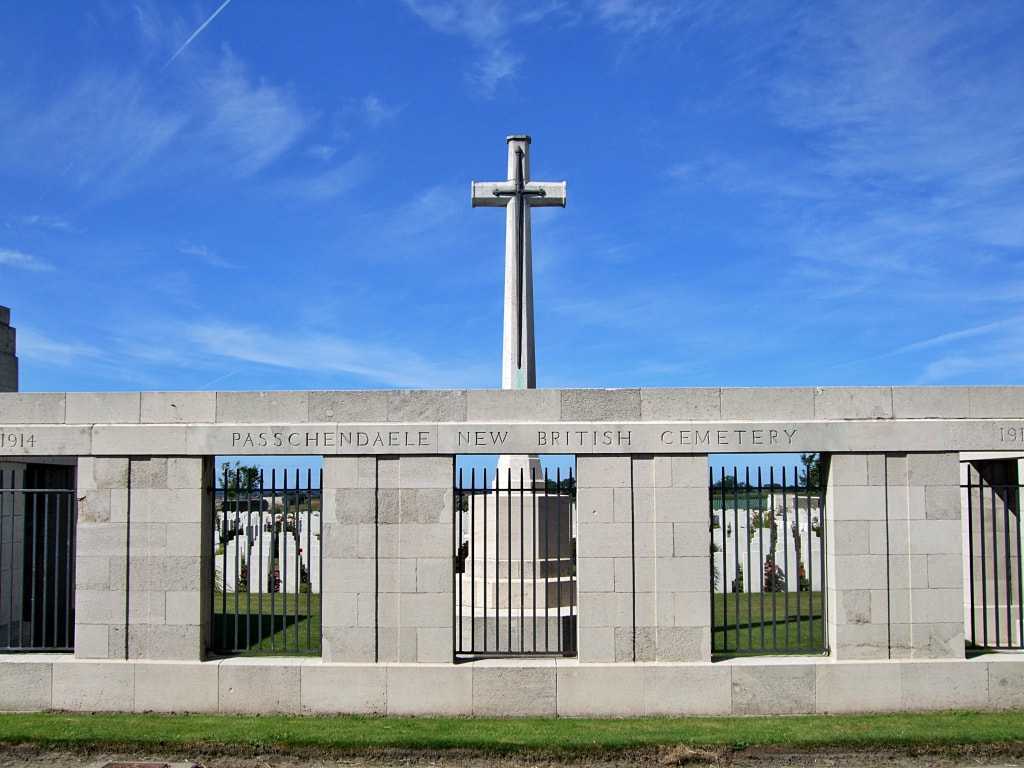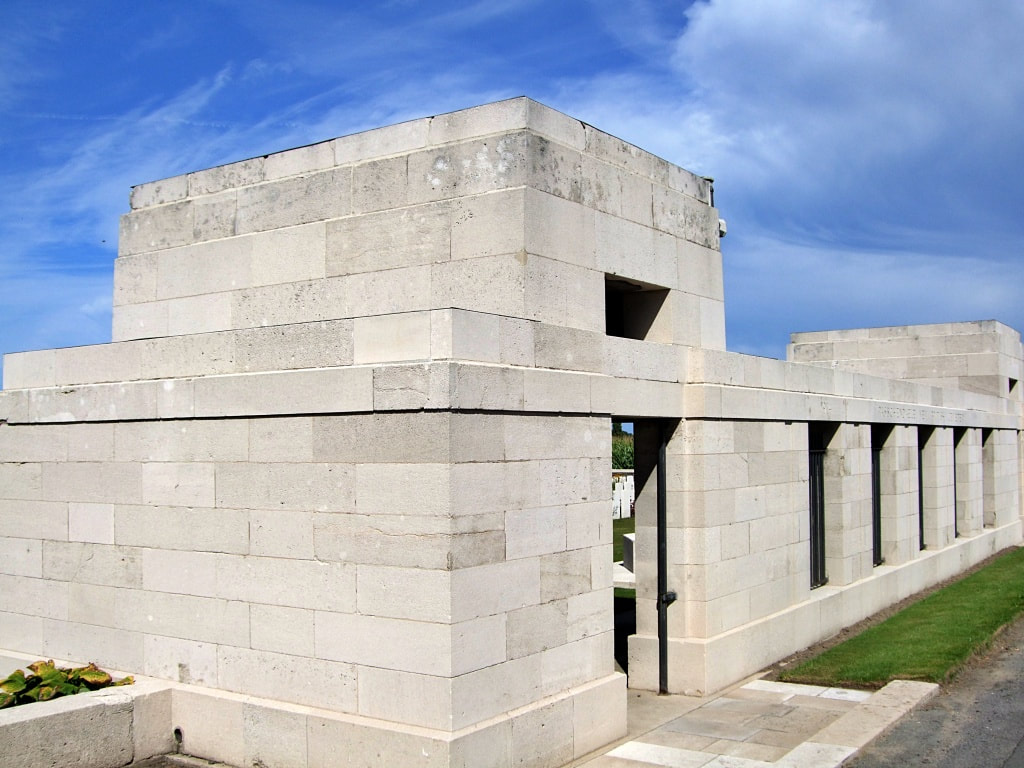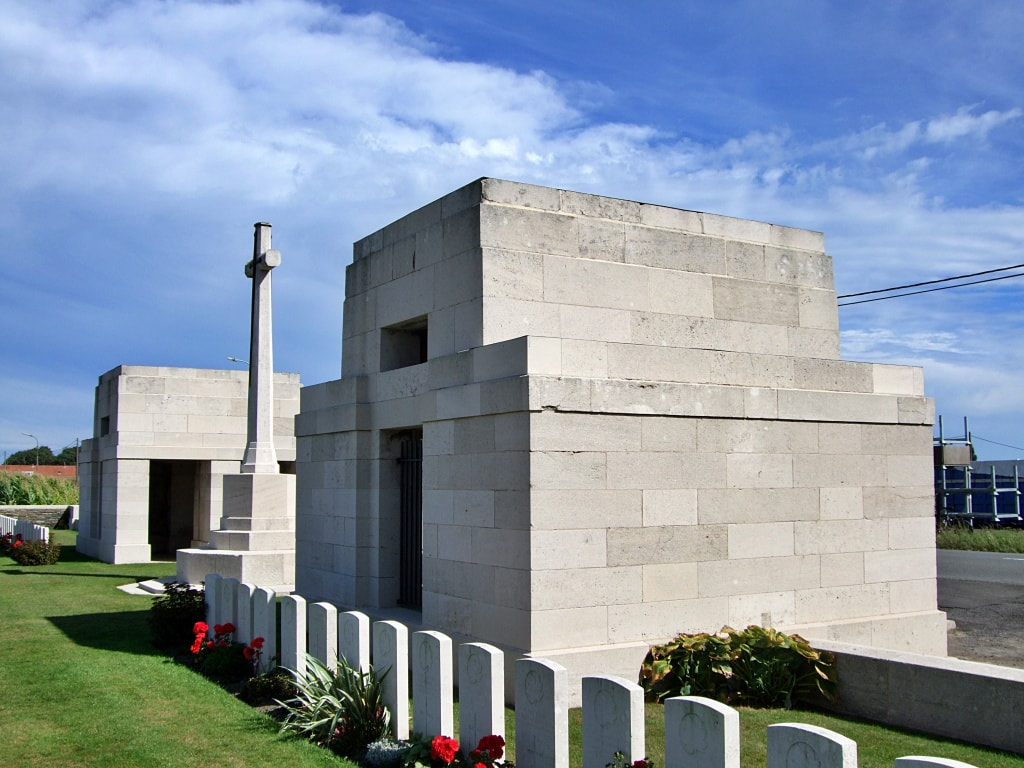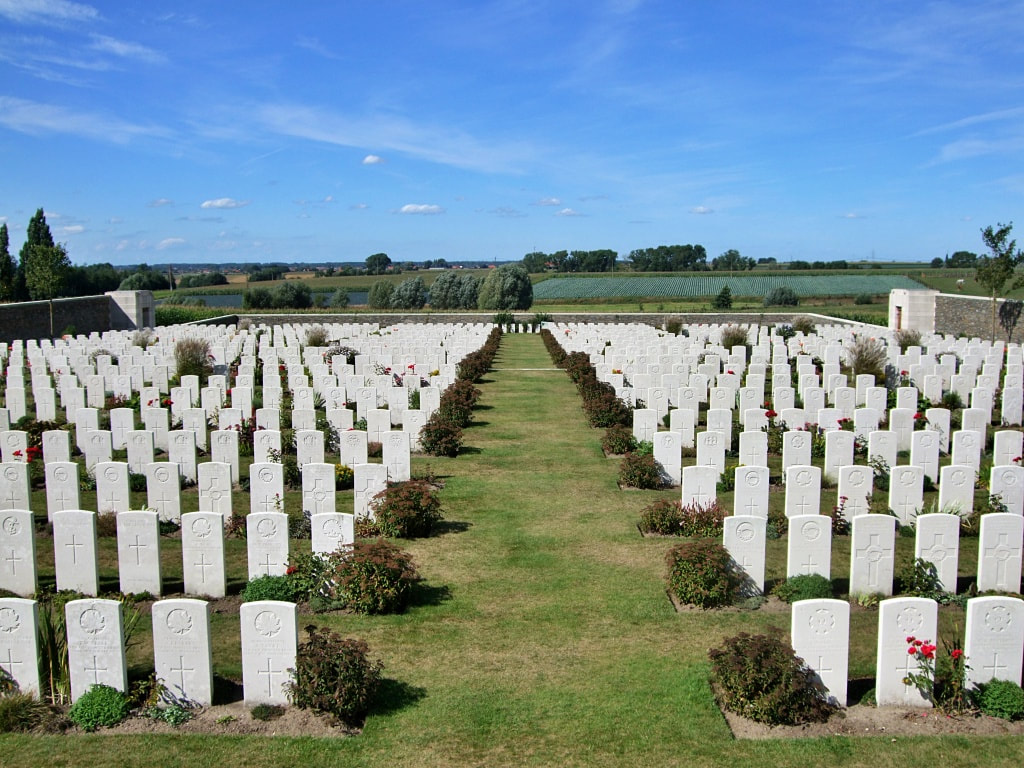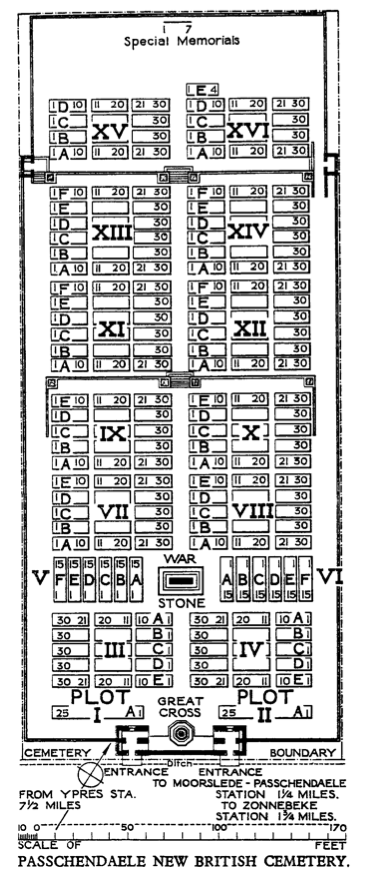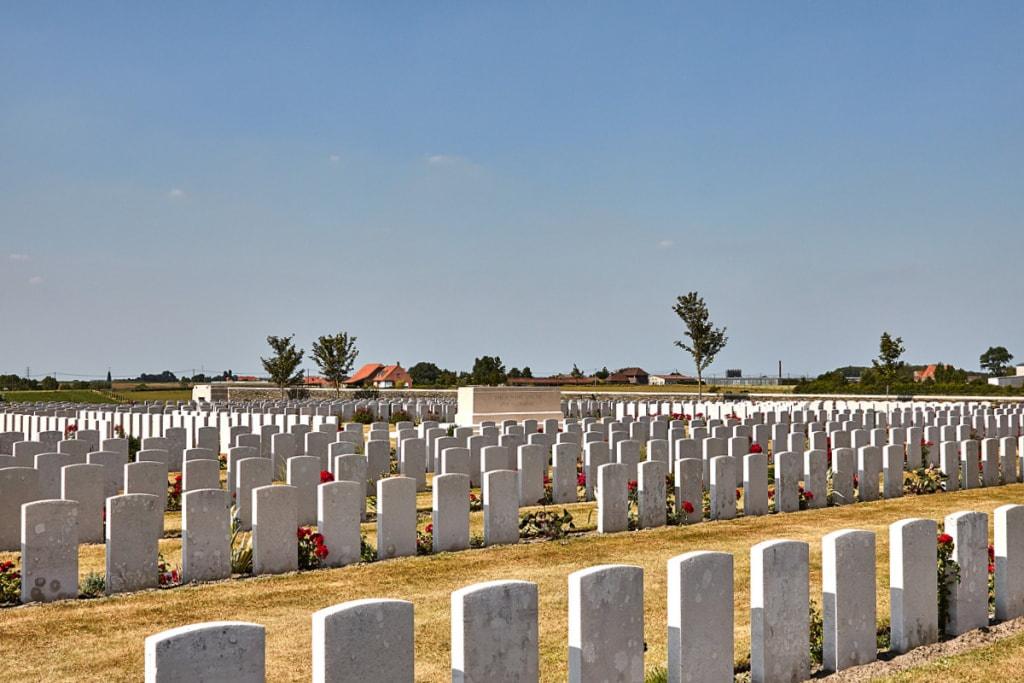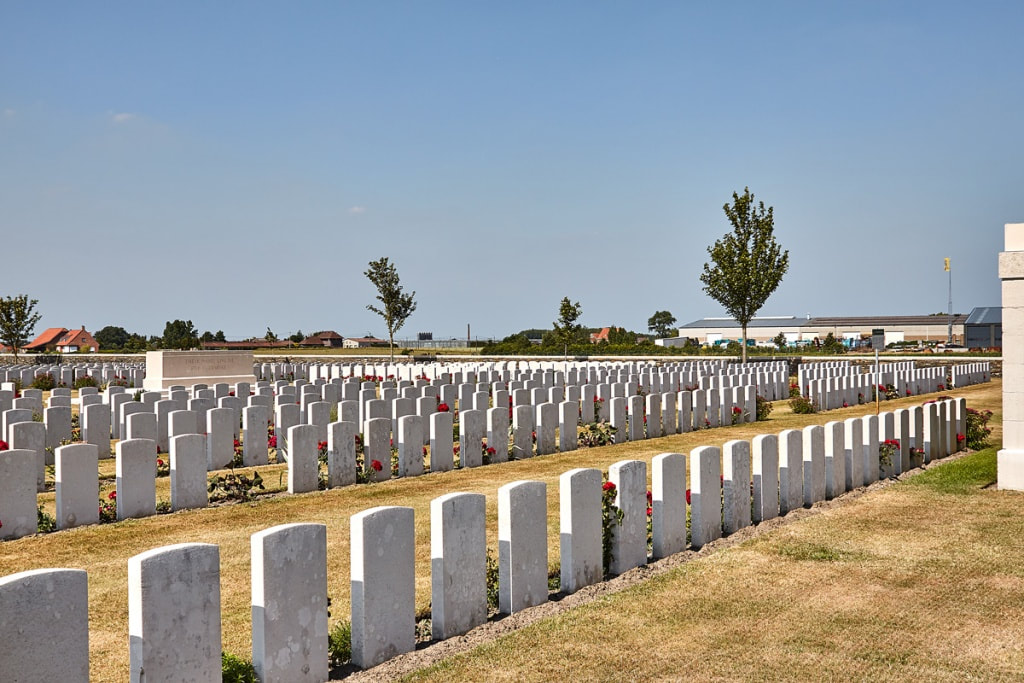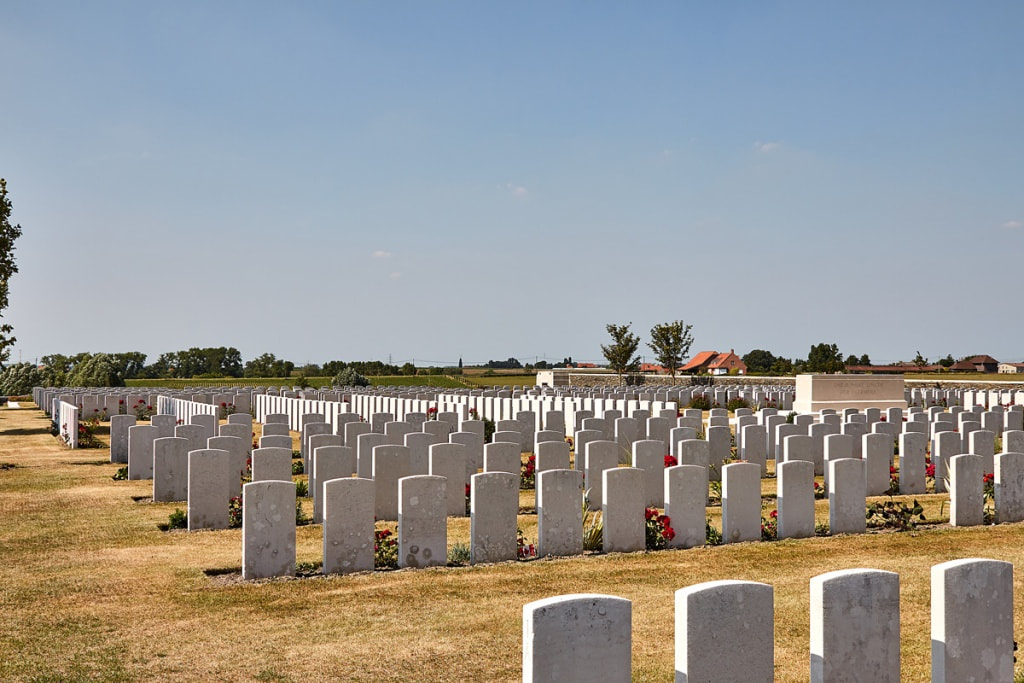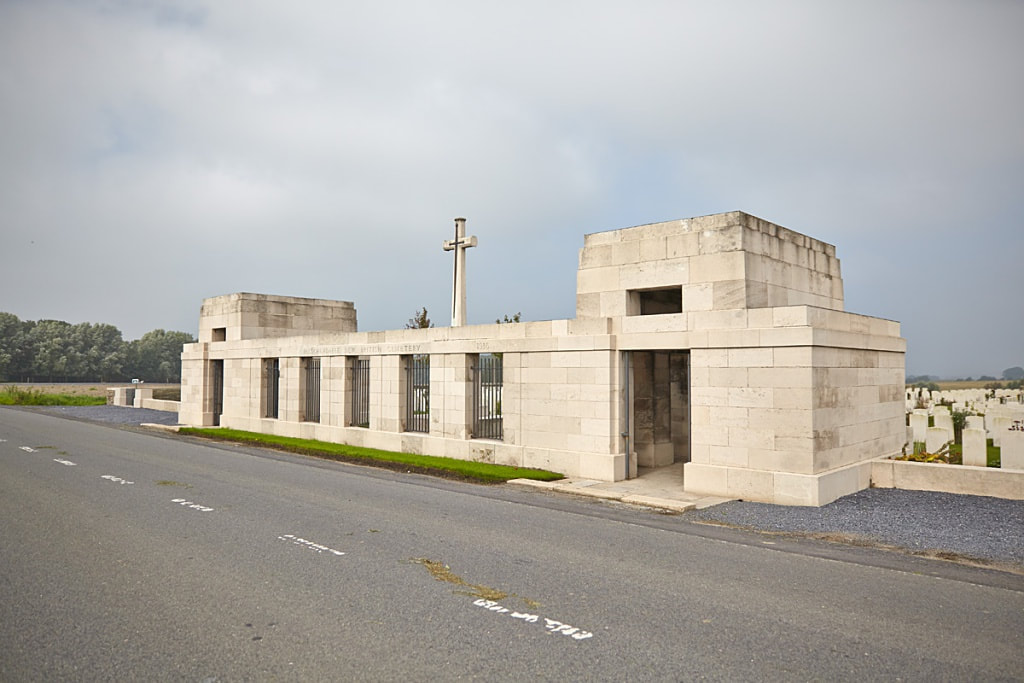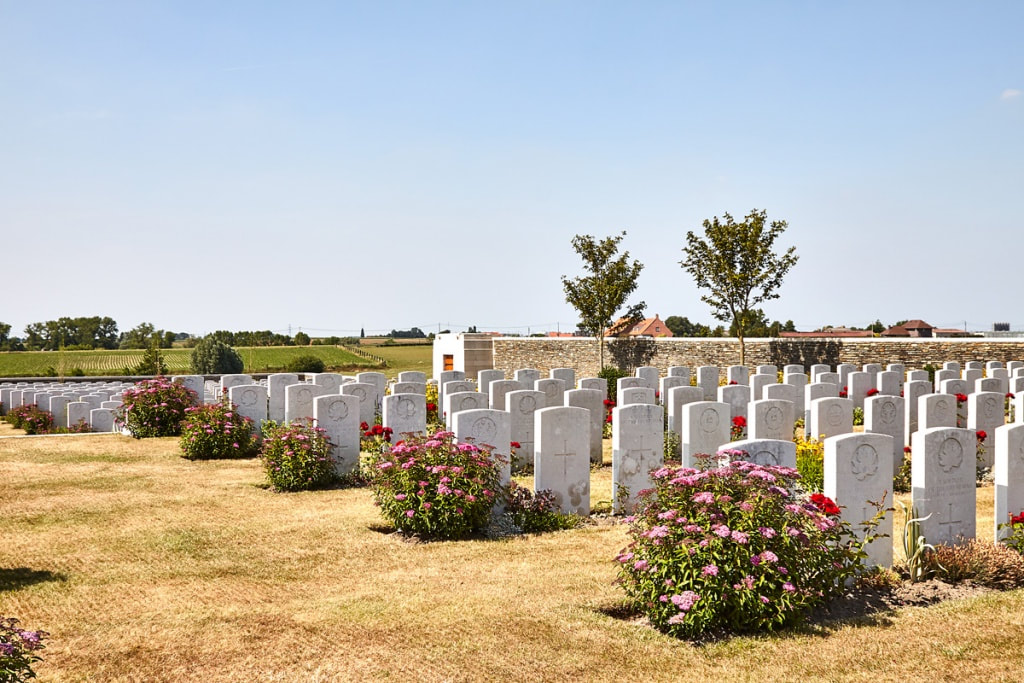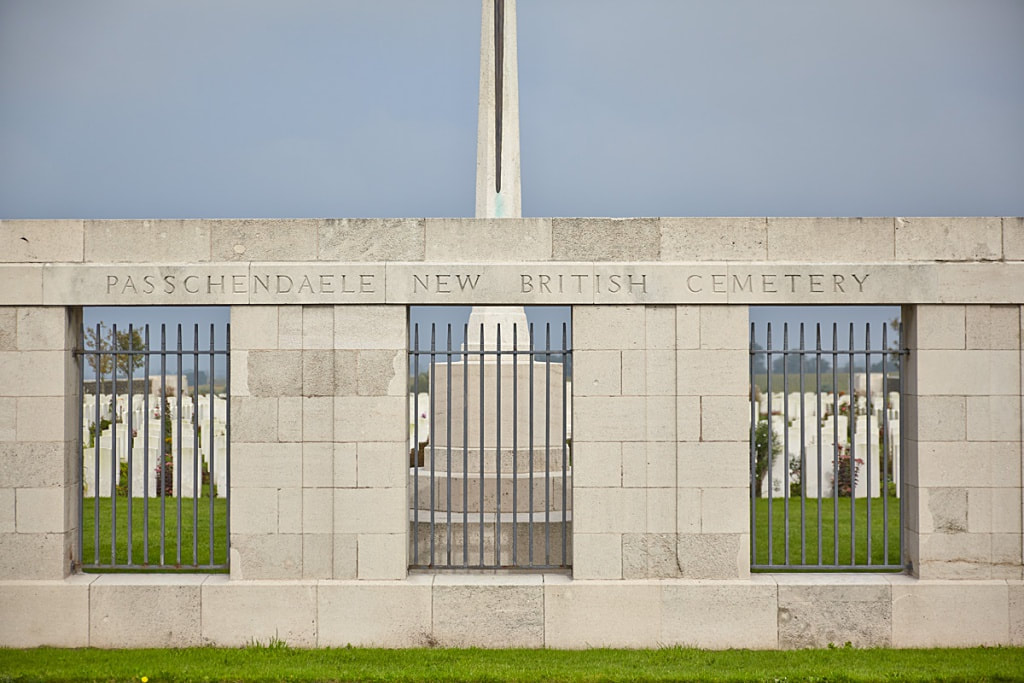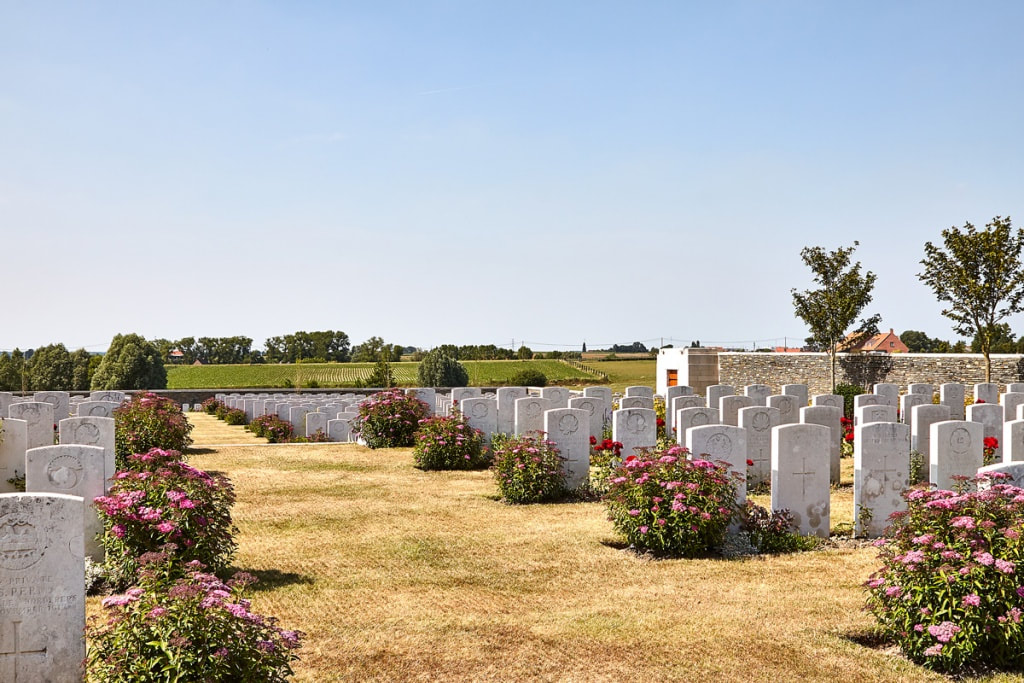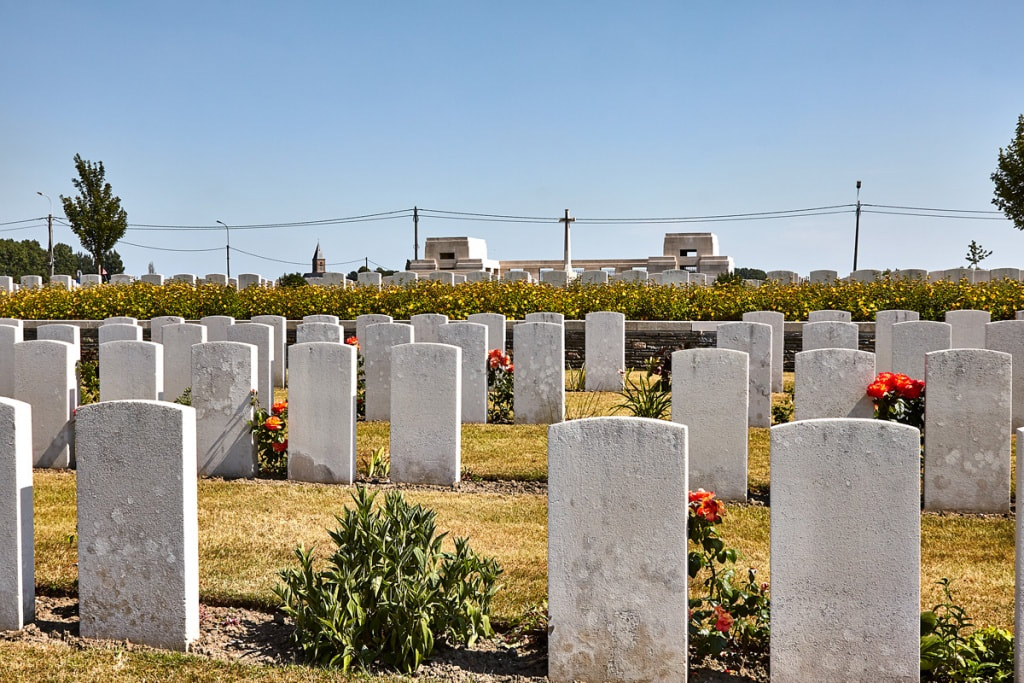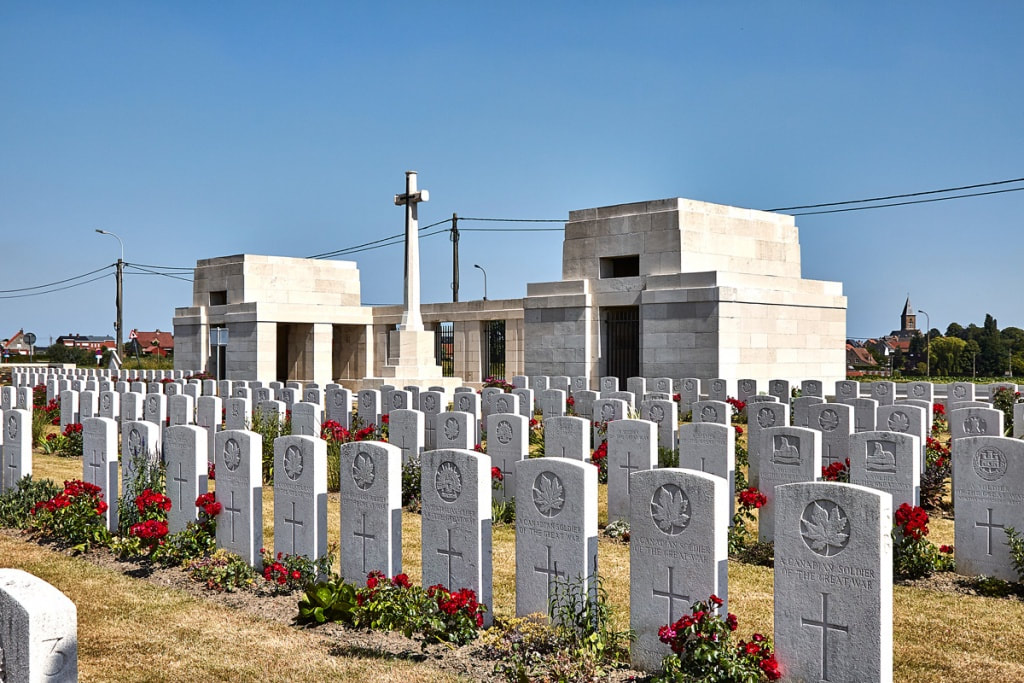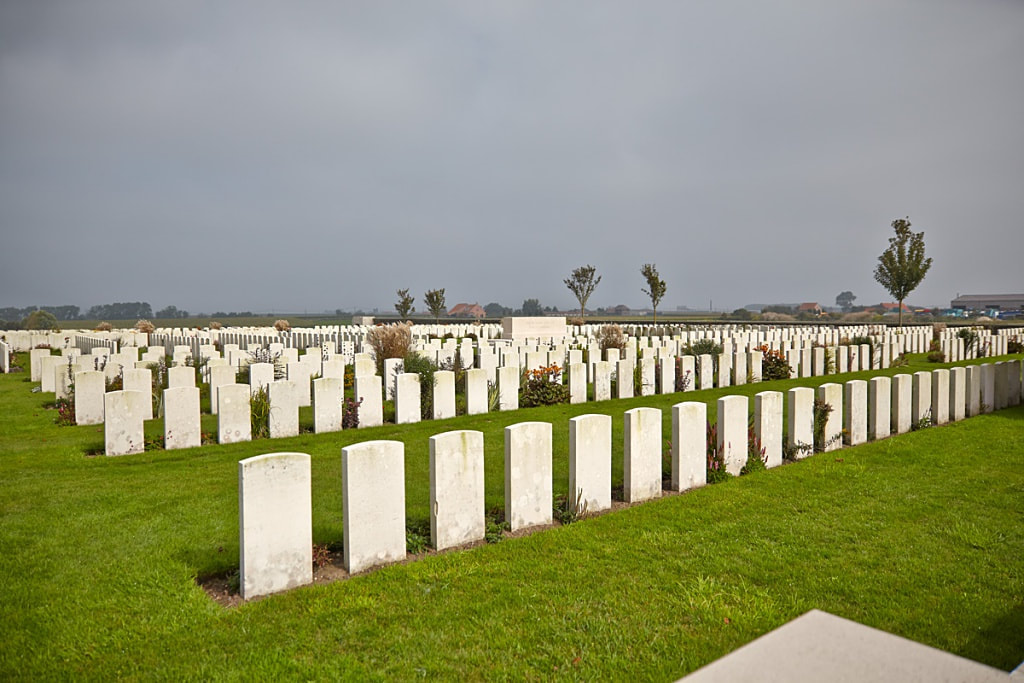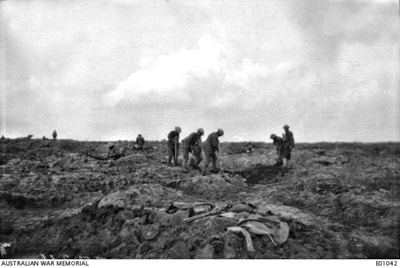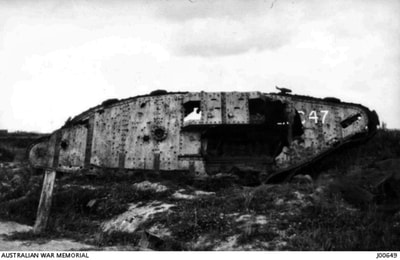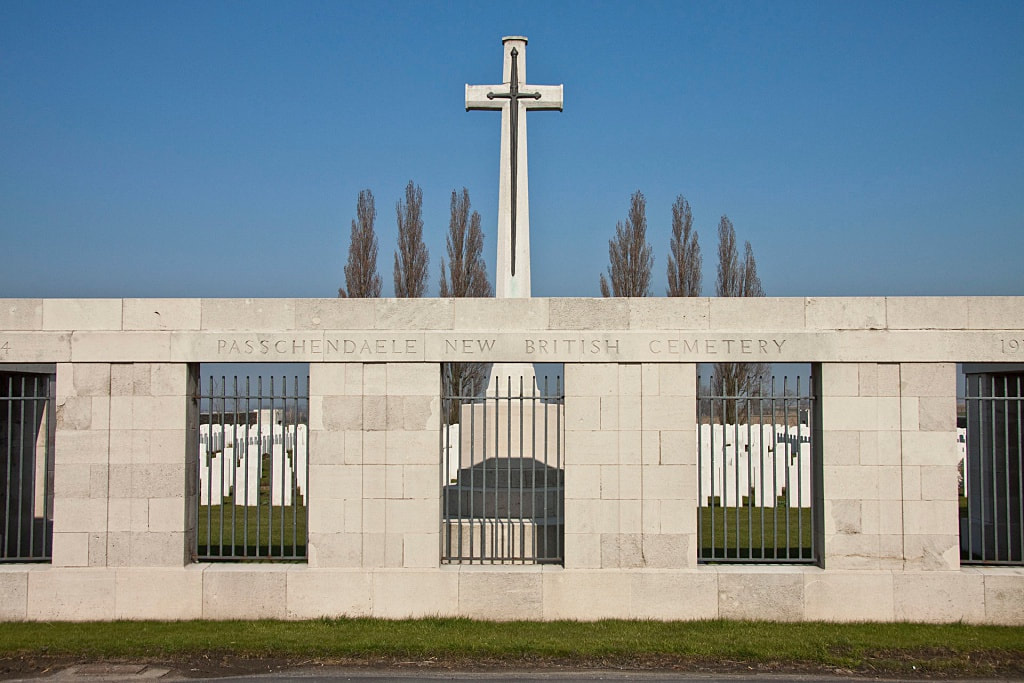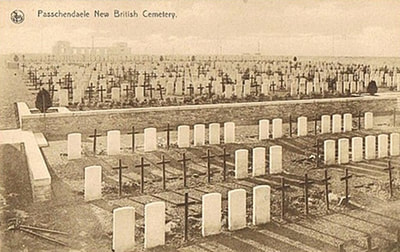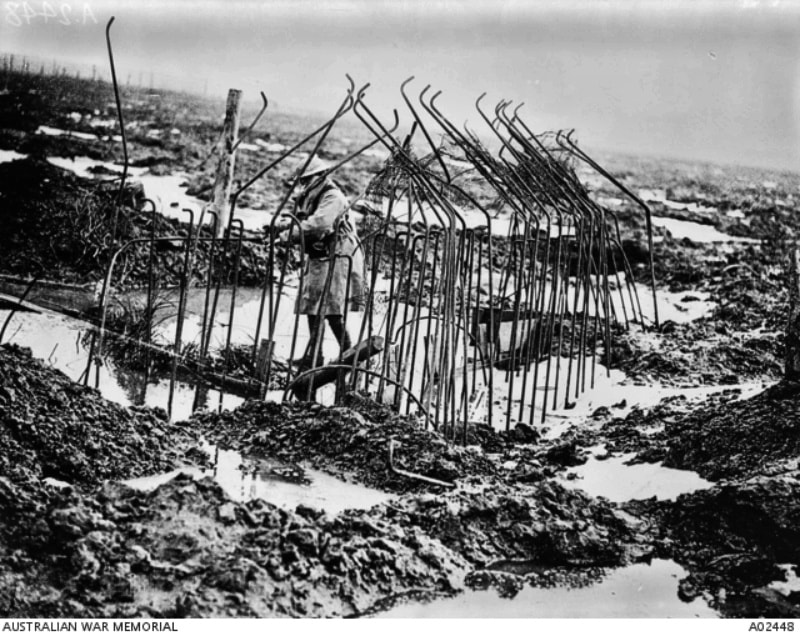PASSCHENDAELE NEW BRITISH CEMETERY
West-Vlaanderen
Belgium
GPS Coordinates - Latitude: 50.90433, Longitude: 3.0109
Location Information
Passchendaele (Passendale) New British Cemetery lies 10.5 Kms north-east of Ieper town centre on the S'Graventafelstraat, a road leading from St Jan to Passendale.
Two roads connect Ieper town centre onto the Zonnebeekseweg; the Torhoutstraat leads from the market square onto a small roundabout. At the roundabout the first right turn is Basculestraat. At the end of Basculestraat, there is a crossroads and Zonnebeekseweg is the turning to the left. 7 Kms along the Zonnebeekseweg, in the village of Zonnebeke, lies the left hand turning onto the Langemarkstraat (further on this street name changes to Zonnebekestraat). 2 Kms along this road, and after passing Dochy Farm New British Cemetery, lies the right hand turning onto the 'S Graventafelstraat.
4 Kms along the 'S Graventafelstraat, and after passing the New Zealand Memorial, lies the cemetery on the left hand side of the road.
Visiting Information
This cemetery is on three different levels, with steps going from one level to another. For wheelchair access between the levels there are grassed ramps to the right of the cemetery, near the wall. Wheelchair users can enter the cemetery via a service entrance situated to the left of the main entrance.
Historical Information
The village of Passchendaele (now Passendale) and surrounding area were associated with every phase of the First World War. In the middle of October 1914, Passchendaele was briefly under Allied occupation but by 20 October it was in German hands, where it remained for the next three years. On 6 November 1917, after the severest fighting in most unfavourable weather, the 5th Canadian Infantry Brigade took, and passed, the village; this fight was part of the Second Battle of Passchendaele, the last of the Battles of Ypres, 1917. In the middle of April 1918, in the Battles of the Lys, the Allied line was withdrawn far back on the road to Ypres, but on 29 September, in the course of the Allied offensive in Flanders, Belgian forces recaptured the village.
The New British Cemetery was made after the Armistice when graves were brought in from the battlefields of Passchendaele and Langemarck. Almost all of the burials are from the autumn of 1917.
The cemetery now contains 2,101 burials and commemorations of the First World War. 1,600 of the graves are unidentified but there are special memorials to seven casualties believed to be buried among them.
The cemetery was designed by Charles Henry Holden and Captain Wilfred Clement Von Berg, M. C.
Total Burials: 2,101.
Identified Casualties: Canada 204, United Kingdom 132, Australia 121, New Zealand 43, South Africa 1. Total 501.
Unidentified Casualties: 1,600.

"Good God, did we really send men to fight in that?"
Field Marshall Douglas Haig's' Chief-of-Staff on visiting the battlefield.
"Good God, did we really send men to fight in that?"
Field Marshall Douglas Haig's' Chief-of-Staff on visiting the battlefield.
Images in this gallery © Geerhard Joos
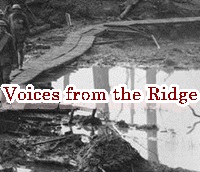
"We could hardly move because the mud was so heavy that you were dragging your legs behind you, and with people being hit and falling and splashing down all around you, all you can do is to keep moving and look for some form of cover. The casualties were very heavy and after we'd somehow managed to get forward maybe 200 yards, I realised that the position was absolutely hopeless. I got a handful of men together and took them into a big crater, more than half full of water. We filled some of these empty sandbags we had with slush, and put them on the edge as a base for the Lewis gun so that we could try to protect our position. And there we stayed." (Lieut. P. King)
Images in this gallery © Werner Van Caneghem
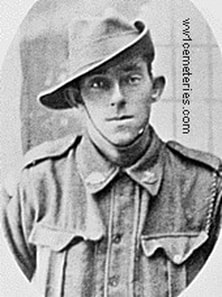
6980 Lance Corporal
William Ernest Dickson
8th Bn. Australian Infantry, A. I. F.
25th October 1917, aged 24.
Plot IV. E. 6.
Son of Thomas and A. Dickson, of 77, Dennis St., Northcote, Victoria, Australia.
A boot finisher prior to enlistment, Pte Dickson embarked from Melbourne with the 23rd Reinforcements on HMAT Hororata on 23 November 1916. He was promoted to Lance Corporal (L Cpl) and was later killed in action in Belgium on 25th October 1917.
William Ernest Dickson
8th Bn. Australian Infantry, A. I. F.
25th October 1917, aged 24.
Plot IV. E. 6.
Son of Thomas and A. Dickson, of 77, Dennis St., Northcote, Victoria, Australia.
A boot finisher prior to enlistment, Pte Dickson embarked from Melbourne with the 23rd Reinforcements on HMAT Hororata on 23 November 1916. He was promoted to Lance Corporal (L Cpl) and was later killed in action in Belgium on 25th October 1917.
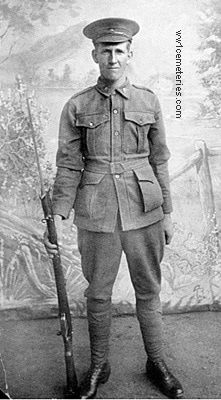
1746 Private
David Gow
45th Bn. Australian Infantry, A. I. F.
13th October 1917
Plot XI. E. 28.
He enlisted in the town of Obley, NSW, on 31 December 1915. He was assigned to the 45th Battalion and subsequently served on the Western Front in France. In October 1917, Gow's battalion was a unit of the 12th Brigade and was engaged in action at Passchendaele where he was killed.
4266 Private P. C. Pearce witnessed David Gow's death:
"I was a Lewis Gunner and in the same team as Gow. In front of Polygon Wood, a shell got the three men of our team that were in an advanced post. I was fifteen yards or so behind them with the rest of our crew. Gow was blown to pieces."
David Gow
45th Bn. Australian Infantry, A. I. F.
13th October 1917
Plot XI. E. 28.
He enlisted in the town of Obley, NSW, on 31 December 1915. He was assigned to the 45th Battalion and subsequently served on the Western Front in France. In October 1917, Gow's battalion was a unit of the 12th Brigade and was engaged in action at Passchendaele where he was killed.
4266 Private P. C. Pearce witnessed David Gow's death:
"I was a Lewis Gunner and in the same team as Gow. In front of Polygon Wood, a shell got the three men of our team that were in an advanced post. I was fifteen yards or so behind them with the rest of our crew. Gow was blown to pieces."

2464 Private
Victor Oxley
45th Bn. Australian Infantry, A. I. F.
13th October 1917
Plot XI. E. 20.
Killed by a shell burst whilst manning a Lewis Gun.
Picture courtesy of Roxanne Gregory
Victor Oxley
45th Bn. Australian Infantry, A. I. F.
13th October 1917
Plot XI. E. 20.
Killed by a shell burst whilst manning a Lewis Gun.
Picture courtesy of Roxanne Gregory
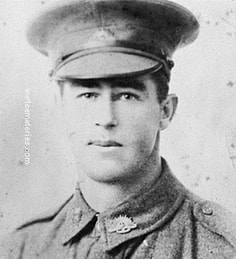
2470A Private
Claude William Bruce Pegler
51st Bn. Australian Infantry, A. I. F.
12th October 1917, aged 30.
Plot XIII. C. 16.
Son of George Charles and Janet Pegler, of 16, Simpson St., West Perth, Western Australia.
A railway Head Shunter prior to enlistment, Pte Pegler also served for two and a half years in the Western Australian Infantry Regiment before enlisting in the AIF on 3 April 1916. He embarked on HMAT Uganda (A66) from Fremantle on 20 September 1916, along with his brother 2468 Pte Charles "Charlie" Thomas Pegler, also of the 51st Battalion. Pte Claude Pegler received wounds to his left leg in action on 11 June 1917, and after convalescence, returned to the field a month later. He was killed in action at the Battle of Broodseinde on 12 October 1917, aged 30. His brother was wounded by the same shell and was subsequently repatriated to England, then Australia due to injuries.
Claude William Bruce Pegler
51st Bn. Australian Infantry, A. I. F.
12th October 1917, aged 30.
Plot XIII. C. 16.
Son of George Charles and Janet Pegler, of 16, Simpson St., West Perth, Western Australia.
A railway Head Shunter prior to enlistment, Pte Pegler also served for two and a half years in the Western Australian Infantry Regiment before enlisting in the AIF on 3 April 1916. He embarked on HMAT Uganda (A66) from Fremantle on 20 September 1916, along with his brother 2468 Pte Charles "Charlie" Thomas Pegler, also of the 51st Battalion. Pte Claude Pegler received wounds to his left leg in action on 11 June 1917, and after convalescence, returned to the field a month later. He was killed in action at the Battle of Broodseinde on 12 October 1917, aged 30. His brother was wounded by the same shell and was subsequently repatriated to England, then Australia due to injuries.

654709 Private
Charles Ivan Wightman
58th Bn. Canadian Infantry
26th October 1917, aged 23.
Plot V. B. 10.
Picture courtesy of Louise Armstrong, who wrote the following
"My son & I visited his gravesite last October, 2019. It was pretty emotional - I just wanted to bring him home. As far as I know we are the only family members from Canada to have visited him. He was from a small town in Huron County, Ontario.
Charles Ivan Wightman
58th Bn. Canadian Infantry
26th October 1917, aged 23.
Plot V. B. 10.
Picture courtesy of Louise Armstrong, who wrote the following
"My son & I visited his gravesite last October, 2019. It was pretty emotional - I just wanted to bring him home. As far as I know we are the only family members from Canada to have visited him. He was from a small town in Huron County, Ontario.
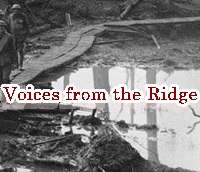
"The salient was a dead loss. I cannot think how the one or two senior officers there who had brains let the thing go on. Of course, they were helping the French out which makes a big difference. One doesn't know what the higher strategy was. But from the tactical side it was sheer murder. You had this Ypres - Yser Canal and you got the strangest feeling when you crossed it. You'd almost abandon hope. And as you got further out you got this awful smell of death. You could literally smell it. It was just a complete abomination of desolation. I wept when I came into the salient." (Second Lieut. H. L. Birks)


